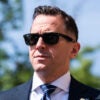In 1971, the Supreme Court upheld a 1955 law making it illegal for federal employees to strike against the U.S. government.
So, when members of the Professional Air Traffic Controllers Organization union went on strike in August 1981, demanding a $10,000 a year bump in pay and a reduction in the workweek from 40 hours to 32, President Ronald Reagan handed them their walking papers—11,000 of them.
It was a decisive action that needed to be taken to ensure the airline industry could continue to serve its customers safely—and to safeguard the American economy.
The Daily Signal depends on the support of readers like you. Donate now
>>> What’s the best way for America to reopen and return to business? The National Coronavirus Recovery Commission, a project of The Heritage Foundation, assembled America’s top thinkers to figure that out. So far, it has made more than 260 recommendations. Learn more here.
On Sunday, the Chicago Teachers Union voted not to have teachers return to the classroom as they were set to do on Monday. Families were eager to see teachers head back to the classroom, but the union defied Chicago Public Schools’ plan to reopen.
Chicago Public Schools—the third-largest school district in the country—has been closed to in-person instruction since the COVID-19 pandemic began in March. For all of those 10 months, the more than 355,000 students in the public school district have not had access to in-person instruction.
Parents have good reason to be dissatisfied with the virtual offerings: Even by late summer, nearly half of the district’s elementary school teachers were not even logging on to the online learning platforms three times a week.
The district has argued the unions’ refusal to have teachers report for in-person work is tantamount to a strike, which violates the collective bargaining agreement they have with Chicago Public Schools.
As Reagan had previously said of teachers unions, “They insist on the right to strike and tenure at the same time. How can you do this?”
Students in Chicago aren’t the only ones who have been denied in-person instruction for 10 months. Los Angeles Public Schools, the second-largest school district in the country, has yet to open its doors. New York City Public Schools, the largest school district in America, has reopened intermittently over the past several months, creating significant uncertainty for parents and students with conflicting official statements day to day.
Parents in other districts are also frustrated with being at the whim of chaotic reopening plans. Just last week, the president of the Fairfax Education Association, a teachers union in Northern Virginia, said she opposes a return to full-week, in-person instruction until all students are vaccinated.
As the group Open Fairfax Public Schools noted, most medical experts do not expect that to happen until at least 2022.
What’s more, the teachers union demanded that teachers in Northern Virginia be prioritized on the vaccine list, and teachers began receiving vaccinations earlier this month. Despite that, they are refusing to commit to returning to in-person instruction next fall.
Across the country, more than half—53% of students—do not have access to regular in-person learning, instead receiving instruction entirely remotely, according to a new nationally representative survey by Education Next.
The survey also revealed major differences in the types of learning to which children have access across school sectors. Whereas only 24% of children in traditional public schools currently attend school in person, a full 60% of children in private schools do so.
Reagan’s resolve with the air traffic controllers was not unprecedented. As governor of Massachusetts in 1919, Calvin Coolidge broke a strike by the Boston City Police, telling union boss Samuel Gompers, “There is no right to strike against the public safety by anybody, anywhere, anytime.”
Nearly a year of crisis online learning, with children separated from their teachers and friends, has threatened the mental well-being and overall educational progress of so many around the country. The number of students receiving “F’s” in two classes has increased by 4,300 this year in Virginia’s Fairfax County alone.
It’s so unnecessary: A recent report from the Centers for Disease Control and Prevention found that in-person instruction is rarely a source of coronavirus outbreak. In-person learning is one of the safest activities for children, yet millions of children across the country continue to have that important tool foreclosed to them.
State leaders across the country should take a cue from the fortitude Reagan demonstrated with the air traffic controllers, and before that, the strength Coolidge showed with the police union.
It’s past time for decisive action. Parents and students deserve as much.
And if schools continue to remain closed to in-person instruction, families should be able to take their child’s education funding elsewhere. Private schools across the country are open and ready for their business.
Have an opinion about this article? To sound off, please email letters@DailySignal.com and we will consider publishing your remarks in our regular “We Hear You” feature.




























